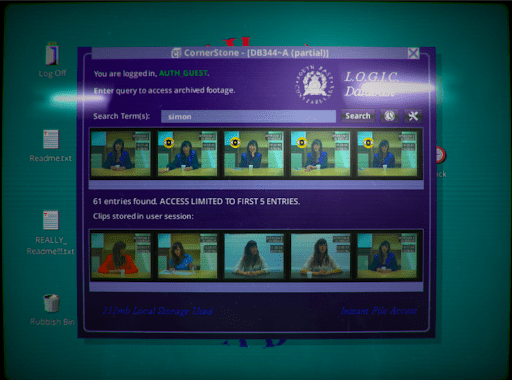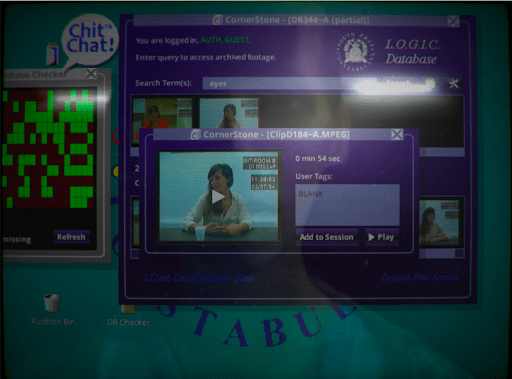Game: Her Story
Audience: People that like detective games, Ages 16+
Creator: Sam Barlow
Platform: Steam
In Her Story, the minimalist computer interface and nonlinear loops of discovery through snippet searching empowers players to actively participate in the unraveling of the mystery and create a narrative arc that is shaped by individual choices and interpretations rather than predetermined paths.
Instead of presenting the story through linear progression or conventional dialogue trees, Her Story develops its narrative through nonlinear discovery from over 200 video snippets from seven police interview sessions. At the start of the game, the player assumes the role of an investigator tasked with the objective to piecing together the truth behind a mysterious crime. This is done by searching through a database using keywords spoken in the interviews. The catch is that you can only view the top five results for each search term, compelling the player to think critically about their choice of words and to keep track of the information they uncover.

For example, as seen above, “simon” has 61 entries but we are limited to seeing the top 5 clips. This mechanic of searching through snippets mirrors the fragmented nature of real investigations, where clues are scattered and the truth is found through deduction. This creates an embedded narrative because you construct the plot through clues and speculation. Without any provided rules, I found myself searching several alternate keywords that pushed the boundaries of the game with the sole purpose of discovering new clips. There was no real penalty for searching up a specific word, so even if it was explicit, it worked.
After discovering new clips to watch, I realized that there were these loops of discovery, where watching new videos led to new keywords to search, which led to new videos to watch. These new videos would often be out of order, so it forced me as a player to make assumptions about the narrative to continue progression. For example, the disparity between who was Hannah and who was Eve led me to debate whether the woman actually had a twin sister, or if she was experiencing dissociative identity disorder. Watching the videos out of order also allowed me to make my own interpretations of the story and try to fill in the gaps with the missing videos.
However, having the video clips be the only real resources in this game made it a bit repetitive and times and hard to find the motivation to continue playing because it would be hours spent just watching videos and trying to find new ones to watch. I think the game could benefit adding ways to see or view items that were pivotal in the videos. For example, I remember watching several videos of the woman examining a couple photos but it would have felt more real and important if I could actually see the photos side by side or in another folder. Having some more resources to interact with would’ve helped add more interaction in the game and make it more engaging to the player.
Moreover, the architecture of the game’s setting as a simple retro computer desktop interface reminiscent immerses the player into the game, while also serving as the magic circle that the player cannot exit until they piece together the entire story. Players are limited to interacting within a database on this computer throughout the entire game. The player assume the role of an outsider peering into this computer screen, reinforcing this sense of detachment, immersing players in an investigative mindset where every revelation feels like a hard-earned victory. The stark contrast between the mundane setting and the weighty subject matter of the narrative enhances the tension and drama of the story.
This leads me to my final point on the open-ended nature of the game’s ending. Within this pretty constant magic circle, we are offered to exit this boundary by entering a chatroom and we are told that our name is Sarah and that this woman who we are investigating (which we assumed to be some stranger) is actually our mother. Rather than neatly tying up loose ends or providing definitive answers, “Her Story” leaves players to draw their own conclusions, inviting speculation and interpretation long after the credits roll. This deliberate ambiguity not only encourages replayability but also sparks more theories later on.



